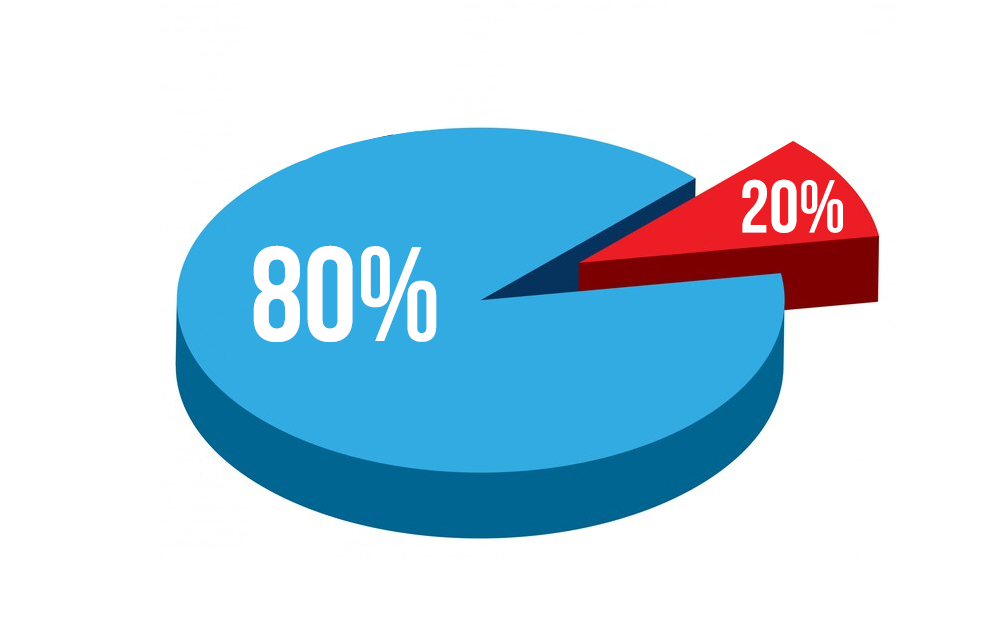It's important to acknowledge the vital role played by administrative professionals in the success of any busi...
Brickwork Blogs


Introduction
In a world where time is a precious commodity, mastering productivity has become a key skill for success. One powerful concept that can significantly boost your efficiency is the Pareto Principle, also known as the 80/20 rule. In this blog, we'll explore how to harness the Pareto Principle to streamline your tasks, prioritize effectively, and supercharge your productivity.
Understanding the Pareto Principle: Unveiling the 80/20 Rule
At the heart of productivity lies a profound concept known as the Pareto Principle, named after Italian economist Vilfredo Pareto. This principle, often referred to as the 80/20 rule, asserts that roughly 80% of outcomes result from 20% of inputs. In the context of productivity, this means that a small fraction of your efforts contributes significantly to most of your results.
Origins and Evolution: Vilfredo Pareto initially observed this phenomenon in the early 20th century when he discovered that 80% of Italy's land was owned by 20% of the population. Over time, this principle has found applications in various fields, from economics to business management and beyond. Understanding its origins provides a foundation for appreciating how this rule can be a game-changer in enhancing productivity.
The Essence of the 80/20 Rule: At its core, the Pareto Principle challenges us to recognize that not all tasks, activities, or inputs are created equal. In the realm of productivity, it suggests that a minority of efforts often leads to most outcomes. This insight prompts a shift in mindset from viewing all tasks as equal to discerning the critical few that significantly impact your goals.
Practical Application: To grasp the Pareto Principle in action, consider a scenario where 80% of your business revenue is generated by 20% of your clients or where 80% of your satisfaction comes from 20% of your activities. By identifying and prioritizing these vital few, you can allocate your resources and energy more efficiently, yielding disproportionate results.
Analyzing Your Own 80/20 Dynamics: To apply the Pareto Principle effectively, reflect on your endeavors. Which tasks contribute the most to your objectives? What activities, when optimized, could lead to substantial improvements? By delving into the specifics of your daily life or work, you can uncover patterns that align with the 80/20 distribution, providing a roadmap for strategic focus.
Holistic View of the Principle: While the classic 80/20 split is a common benchmark, variations exist, such as the 90/10 or 70/30 rule. The essence remains the same: minor efforts tend to produce major results.
Acknowledging these variations underscores the flexible and dynamic nature of the Pareto Principle, encouraging individuals to tailor its application to their unique circumstances.
In essence, understanding the Pareto Principle involves recognizing that not all tasks carry equal weight in influencing your outcomes. By discerning the vital few from the trivial many, you can strategically allocate your time and resources, unlocking a potent strategy for heightened productivity. This principle serves as a powerful lens through which to evaluate and enhance the efficiency of your endeavors, paving the way for transformative results.
Freight Forwarding and the Pareto Rule
The data pattern suggests that 80% of container volume is shipped from 20% of ports and 80% of container volume is also shipped by 20% of companies.
This pattern of data is also applicable to Russia, China, Brazil, and other countries. The same distribution pattern has been found in FCL and LCL, in rail, road, sea, and air freight.
In fact, in some cases, the Pareto distribution chart can turn out to be even more dramatic. For example, the busiest business world trade route panning out from far East Asia imports to Europe with 150 active ports. But only 16 of them (about 10%) are responsible for generating 80% of the total volume.
Applying the Pareto Principle to Task Management
Let's delve into the practical aspects of applying the Pareto Principle to task management for a more streamlined and impactful workflow.
1. Analyzing Your Task List:
2. Categorizing the Vital Few:
3. Prioritizing Based on Impact:
4. Focusing on High-Value Activities:
5. Constant Evaluation and Adjustment:
6. Delegating or Eliminating the Trivial Many:
7. Utilizing Technology to Enhance Efficiency:
8. Balancing Short-Term Wins with Long-Term Goals:
In essence, applying the Pareto Principle to task management involves a strategic and dynamic approach to organizing and prioritizing your workload. By identifying the vital few and allocating resources accordingly, you can transform your task list from a collection of activities into a roadmap for success. This application of the 80/20 rule empowers you to work smarter, not harder, and achieve more with less.

Navigating Your Tasks with the Pareto Principle
Prioritizing tasks effectively is a pivotal aspect of applying the Pareto Principle to your workflow. The 80/20 rule urges us to identify and focus on the vital few tasks that contribute the most to our goals. In this subsection, we will explore various prioritization techniques aligned with the Pareto Principle to help you maximize the impact of your efforts.
1. Urgency and Importance Matrix:
2. Critical Path Analysis:
3. Time Blocking:
4. ABC Method:
5. Value vs. Effort Analysis:
6. Mind Mapping:
7. Batching and Time Efficiency:
8. Customer Feedback and Impact:
9. Regular Review and Adjustment:
Incorporating these prioritization techniques into your task management approach enhances your ability to focus on the vital few tasks that drive most of your success.
Also Read: Freeing Senior Executives for Core tasks by Delegating Routine work
Conclusion
In pursuit of heightened productivity, the Pareto Principle emerges as a guiding force, urging us to focus on the vital few tasks that yield the greatest impact. By understanding and applying the 80/20 rule to task management, we uncover a transformative approach to work that transcends mere efficiency. This principle invites us to question the status quo, analyze our endeavors with a discerning eye, and prioritize with strategic intent.
As we navigate the complex landscape of productivity, the Pareto Principle becomes a beacon of clarity, guiding us to allocate our time and energy where it truly matters. Whether through task prioritization, time management, or strategic decision-making, embracing the essence of the 80/20 rule empowers us to work smarter, achieve more with less, and ultimately, unlock the full spectrum of our potential. Outsource 80% of your administrative tasks and workload to Brickwork’s virtual assistants and focus on your core tasks. Reach out to us today to learn more about our services!


